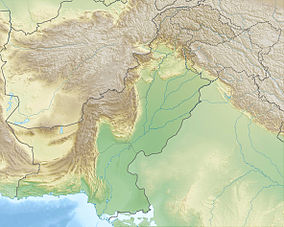|
Chinji National Park
Chinji National Park (shortened as Chinji), established in 1987,[1] is a protected area of IUCN category II (national park) located on Sargodha road Near Chinji Town in District Talagang Punjab, Pakistan.[2] It covers a total area of 6,095 hectares (15,061 acres).[3] Chinji National Park is located close to Salt Range, about 130 km from Islamabad in the south. LandscapeThe area has an elevation imperial of 2,231 feet (680 m). Deeply eroded land of Chinji consists of sandstone to igneous rocks, combined with small deposits of rock salt from the Salt Range. Deep torrential streams and ravines slope into the Soan River, which passes through the area.[citation needed] Climate
Average annual rainfall in the area is 537 mm, out of which 308 mm is in the monsoon season from July to September. Maximum temperature is 27 °C in June and minimum is 2.2 °C in January. Frost is common in winter season. Relative humidity can reach up to 80% in monsoon.[citation needed] WildlifeThe Chinji National Park exhibits the biome of deserts and xeric shrublands and falls in the ecoregion of 'Baluchistan xeric woodlands' (PA1307).[4] The area is characterized to have sub-tropical vegetation with many plant species of importance. A few of the mammals found here include the Urial, Golden jackal, Bengal fox, Indian wolf and Indian pangolin. A few game birds include Grey francolin and Common wood pigeon[5] Fauna and floraList of fauna found in the national park.[6][7]
See alsoReferences
External links
|
||||||||||||||||||||||||||||||||||||||||||||||||||||||||||||||||||||||||||||||||||||||||||||||||||||||||||||||||||||||||||||||||||||||||||||||||||||||||||||||||||||||||||||||||||||||||||||||






































